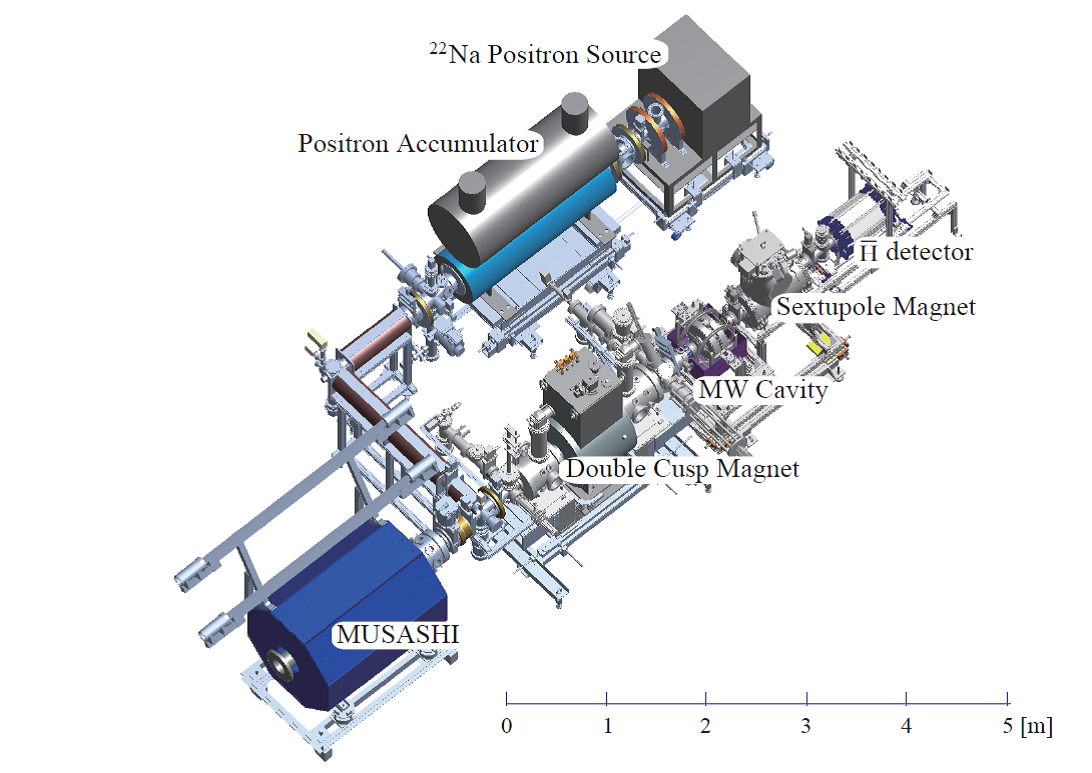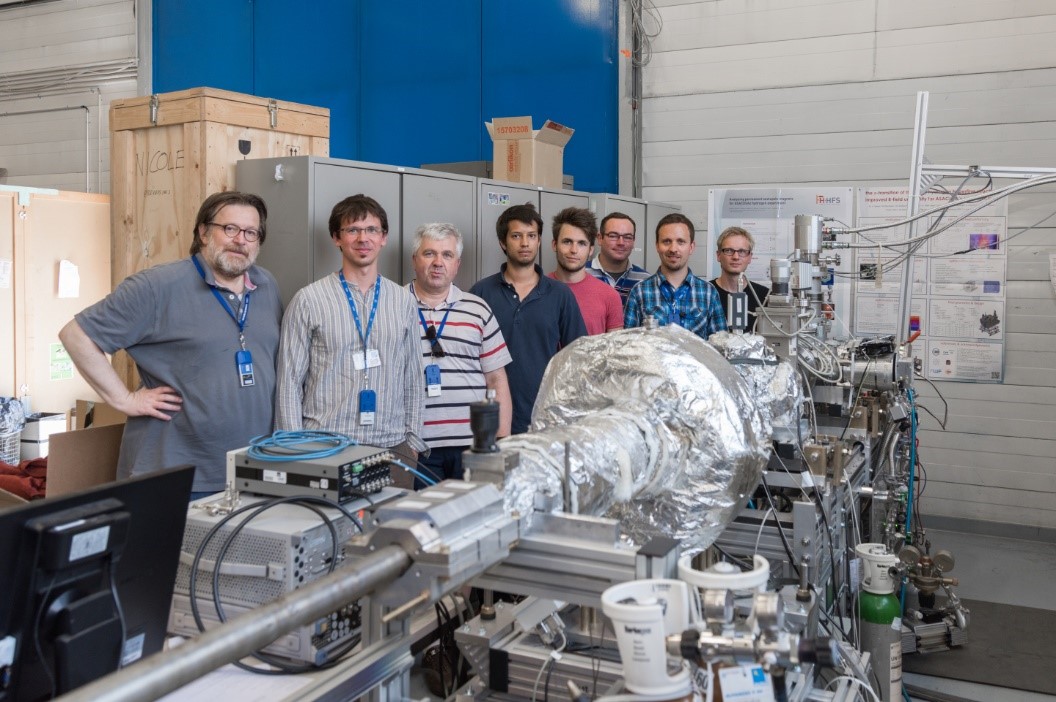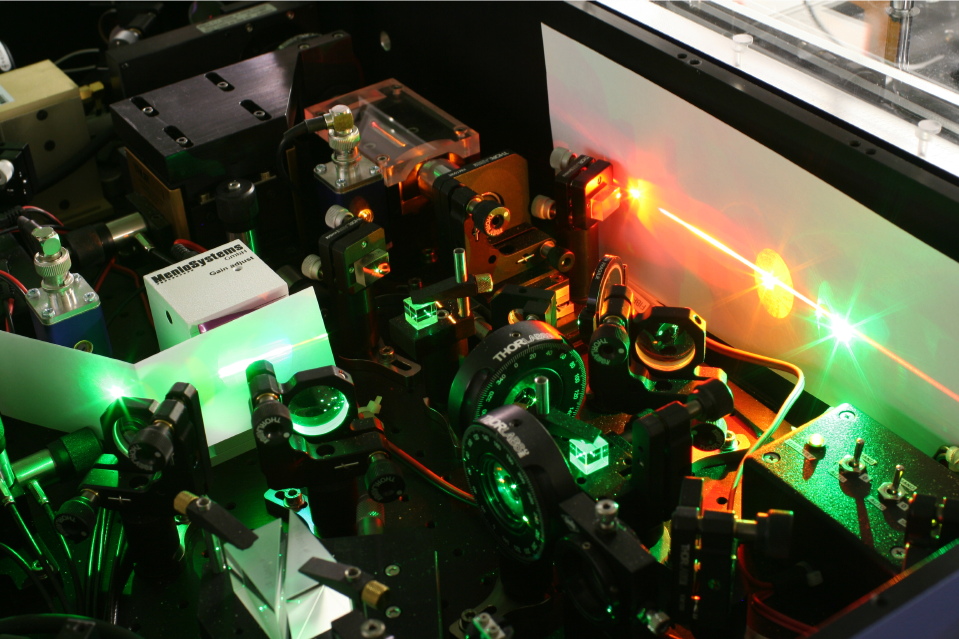ASACUSA Collaboration at CERN AD
ASACUSA (atomic spectroscopy and collisions using slow antiprotons) now works mainly on two subjects, 1) antihydrogen ground-state hyperfine splitting measurement, and 2) antiprotonic helium laser spectroscopy. Both of these aim at CPT tests.
ASACUSA collaboration has a unique infrastructure called the RFQD (radiofrequency quadrupole decelerator), an inverse linac, which decelerates the 5.3 MeV antiprotons extracted from the AD (antiproton decelerator) to 100 keV with a deceleration efficiency of some 30%. This post deceleration increases the trapping fraction of antiprotons into the “MUSASHI” catching trap by about two orders of magnitude, as compared to the conventional degrader method. Antiprotons captured and cooled in the “MUSASHI” trap are being used in our attempt to produce an antihydrogen beam, and to measure the ground-state hyperfine splitting, as detailed in Section 1.
The ground-state hyperfine splitting of antihydrogen will be measured by passing the beam through a microwave cavity (1.4 GHz), and by collecting the spin-flipped antihydrogens with a sextupole magnet. The method has now been perfected by testing the whole setup using an ordinary hydrogen source. This is discussed in Section 2.
The RFQD beam is also used to produce “antiprotonic helium”, a three-body atom composed of a normal helium nucleus with an antiproton, by stopping the slow antiprotons in a cold, dilute, helium gas. We have been working on the precision laser spectroscopy of antiprotonic helium, with which we can deduce the antiproton-to-electron mass ratio, as discussed in Section 3.
Antihydrogen and antiprotonic helium experiments will both benefit very much when the ELENA ring is completed, which can deliver electron-cooled 100 keV antiprotons with high brightness. We are contributing beam monitors, which we have developed and have been using to monitor the RFQD-decelerated antiprotons, to the ELENA projects.
§1 Hyperfine Spectroscopy of Antihydrogen Beam
The ASACUSA-CUSP group comprises about 30 scientists from various institutes in Japan (RIKEN, Univ. Tokyo, and Hiroshima Univ.) and in Europe (SMI and Brescia Univ.). It aims to measure a property of antihydrogen called the “hyperfine structure” precisely and compare it to the well-known value for hydrogen in order to detect any tiny difference for stringent test of the CPT symmetry between matter and antimatter. Since this measurement is very sensitive to magnetic fields, ASACUSA-CUSP aims to create a beam of antihydrogen atoms that can fly to a region where no disturbing fields are present, and to apply a Rabi-type hyperfine spectroscopy scheme (Spectroscopy results using a polarized hydrogen beam are described below).
The experiment is renewed in 2014 with a completely new set-up, which includes a superconducting double cusp magnet, a 3D tracking detector and an upgraded antihydrogen detector. Figure 1 schematically shows the whole setup. Antiprotons from the AD (Antiproton Decelerator) are transported to MUSASHI via the RFQD. MUSASHI then traps, cools, and compresses antiprotons, which are adiabatically transported to the double cusp magnet, and soft-landed on a pre-loaded cold positron cloud to synthesize cold antihydrogen atoms. Positrons emitted from 22Na are moderated by a thin layer of Ne ice and continuously stored in the positron accumulator. Positrons are then pulse-extracted, transported to the double cusp magnet, and stacked in the double cusp magnet, compressed/de-compressed before the injection of antiprotons. Antihydrogen atoms in the low field seeking states are extracted downstream, pass the MW (Micro Wave) cavity to induce hyperfine transitions, the Sextupole magnet for spin analysis, and are finally detected by the antihydrogen detector.
Double cusp magnet: The double cusp magnet consists of a pair of two anti-Helmholz coils, which has a strong focusing capability for antihydrogen atoms in low field seeking states, and yields a spin-polarised beam of antihydrogen atoms.
3D Micromegas Tracker: In the bore of the double cusp magnet, a semi-cylindrical tracker is installed to extract detailed information on the formation processes of antihydrogen atoms. The tracker is a precision three-dimensional annihilation Micromegas detector with the curvature of ~100mm that implements very thin flexible insulator films on which metallic patterns are printed, immersed in a gas mixture to follow the particle trajectory precisely.
Antihydrogen beam detector: At the most downstream, the antihydrogen detector is installed. It consists of a BGO crystal disc in a vacuum and two-layer hodoscope, 32 bars per layer surrounding it. This is essential to allow the experiment to distinguish accurately between antihydrogen particles coming from the beam (which are therefore to be measured and studied) and spurious particles coming from unshielded cosmic rays and from antiproton annihilations upstream of the antihydrogen detector primarily in the cusp magnet.
We are continuously improving the antihydrogen synthesis scheme for the ground state hyperfine spectroscopy. The completion and operation of ELENA will benefit the experiment by further increasing the intensity of antihydrogen beam.

Fig.1: A schematic drawing of the experimental setup for the hyperfine spectroscopy of antihydrogen beam
§2 Polarised hydrogen beam
In order to characterize the Rabi-type hyperfine spectroscopy apparatus (a microwave cavity oscillating at ~ 1.42 GHz and a superconducting sextupole acting as spin selector) developed for antihydrogen spectroscopy, a source of polarized cold atomic hydrogen was built at Stefan Meyer Institute. It consists of a radio frequency discharge to create atomic hydrogen, two permanent sextupoles to polarize the beam and to narrow the velocity distribution, as well as a commercial quadrupole mass spectrometer to detect hydrogen atoms.
The setup was first installed in the CERN cryolab and later in Bldg. 275. In a first series of measurements, one of two possible hyperfine transitions, the so-called σ1 transition, was studied and its value has been determined with an accuracy of 3 ppb by applying a small static magnetic field and extrapolating to zero external magnetic field. This proves that the apparatus is capable of achieving a high precision provided an intense enough antihydrogen beam becomes available.
The next step is to measure the second transition (π1) which is more sensitive to magnetic field inhomogeneity. New Helmholtz coils with additional correction coils have been built and an improved magnetic shielding has been designed. Measurements will commence in September. Using this setup, it will also be possible to determine some coefficients of the Standard Model Extension SME by Alan Kostelecky et al. which are sensitive on Lorentz Invariance Violation.

Fig. 2: Members of Stefan Meyer Institute in front of the polarized hydrogen beam at CERN.
source: CERN
§3 Determination of the antiproton-to-electron mass ratio by laser spectroscopy of antiprotonic helium
Antiprotonic helium is a three-body atom composed of a normal helium nucleus with an antiproton orbiting a highly-excited state, and an electron orbiting the ground state. The ASACUSA collaboration synthesizes large numbers (109) of these atoms and shoots powerful laser beams with a high degree of monochromaticity on them, which causes the antiproton in each atom to transfer from one quantum orbital to another. The characteristic transition frequencies of the atom are measured by detecting the resonance condition between the laser beam and the atom. By comparing these experimental results with theoretical quantum-electrodynamics calculations, the antiproton-to-electron mass ratio Mp-/me is determined to sub-parts-per-billion scale precision. This ratio derived by ASACUSA has so far agreed with the proton-to-electron values obtained by other experimental groups to an even higher level of precision.
In past experiments carried out by ASACUSA, the thermal motions of the atoms in the experimental apparatus caused an uncertainty (called the Doppler broadening) in the determination of the antiproton-to-electron mass ratio. We have spent the last few years perfecting two techniques to improve the experimental precision beyond this limit. The first involves irradiating the atom with two counterpropagating laser beams to cancel the effect of this Doppler broadening, and observe narrow spectral lines. The second technique involves the cooling down of our samples of atoms to cryogenic temperatures below T=2 K. The collaboration will soon publish an improved value on the antiproton-to-electron mass ratio. For these experiments, we relied on valuable help provided by the CERN cryogenics laboratory.
Further large improvements in the experimental precision of Mp-/me are expected once the ELENA storage ring comes into operation. New higher-precision lasers and experimental targets are being developed for these future experiments.

Fig 3: Detail of laser system used for experiments on antiprotonic helium.
The author would like to thank Y. Yamazaki, E. Widmann and M. Hori for their invaluable contributions to this article.
